Propagating mussels is difficult for lots of reasons, but their dependence on a live host fish always creates a challenge. Fish survival at the hatchery is usually strong, but the more you handle them, the more prone they are to disease since you damage the protective mucous coat or even dislodge scales and infesting fish with freshwater mussel glochidia involves a lot of handling. Propagation becomes even more arduous when the glochidia transform over months, rather than weeks since you have to keep your fish healthy over long, cold months when they don’t eat much and they’d rather be buried in the mud in a deep river hole. Successfully producing juvenile Winged Mapleleaf, a federally endangered mussel, depends on this over-wintering, as does the Washboard, North America’s largest native freshwater mussel.
Less successful seasons see the loss of these host fish due to disease, and therefore the loss of Winged Mapleleaf larvae, but treatments are required to manage illness, while not harming the developing glochidia. One of our graduate pathways interns has taken this topic on as her graduate thesis work. She is treating Washboard-infested Channel Catfish weekly with typical fish disease treatments to determine whether they decrease the number of quality of juveniles dropping off the fish in the spring. Many treatments have been tested in bass infested with Plain Pocketbook to confirm that they don’t impact the new juveniles, but none have been tested for multiple uses, or over multiple months. Being able to manage disease in Winged Mapleleaf-infested Channel Catfish will make a difference in the success of the recovery program for this species and others across the country.
By: Megan Bradley

Lake Trout eyed eggs. Photo: Erica Rasmussen/USFWS.
As we shared with you in our September edition of Genoa News and Notes, we received Lake Trout eggs from Cayuga Lake in New York that were spawned between October 5-7. The eggs have been incubating since then at 46° F using a chiller unit to cool our well water down from 51° F. Eggs from each set of parents were kept separate from each other. Eggs began hatching on 12/7 and continued until 12/13. Since this is a future broodstock lot, we wanted to maximize the genetic makeup of our lot of fish to the greatest extent possible. We were able to get contributions to the lot from 79 sets of parents for a total of about 1700 fish. These fish will grow up on station until 2023, when they will be sent to their new home at Iron River National Fish Hatchery. There, they will be crossed with other lots of Lake Trout to create a genetically diverse line of production fish that will be stocked to the Great Lakes.
By: Nick Bloomfield
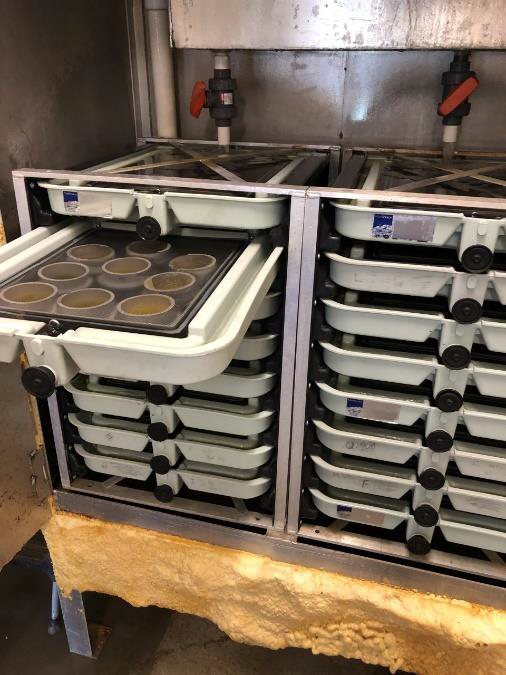
Chiller unit with about 16 trays that are holding about 9 cups filled with eggs. Photo: Erica Rasmussen/USFWS.
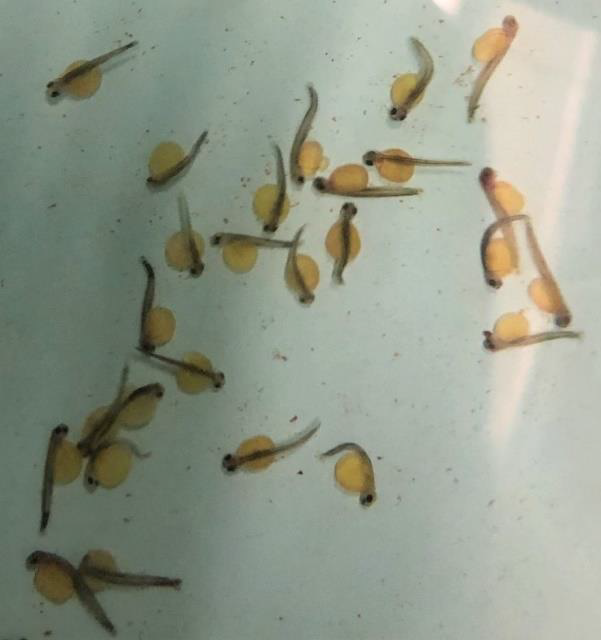
Lake Trout with yolk sac visible. Photo: Erica Rasmussen/USFWS.
Volunteers play a vital role in supporting the U.S. Fish and Wildlife Service’s mission: working with others, to conserve, protect and enhance fish, wildlife, and plants and their habitats for the continuing benefit of the American people. The Genoa National Fish Hatchery relies on volunteers to manage the bookstore in the Great River Road Interpretive Center and provide information to the general public about the facility, assist with lake sturgeon and brook trout coded wire tagging, pond harvesting in the spring and fall, mussel cage repairs and tagging of freshwater mussels. Volunteers donate their precious time in helping us at the hatchery complete our mission and for that we are extremely appreciative. Even amid a pandemic, volunteers stepped up to the plate to lend a helping hand while following federal guidelines on mask mandates and social distancing. A combination on 62 volunteers tagged over 60 thousand lake sturgeon and brook trout and donated 229 hours of their time, 12 volunteers harvested fish and mussel ponds and tagged mussels for 25 hours, and 6 volunteers teamed up to staff our visitor center bookstore and volunteered 275 hours while hosting over 1500 visitors from July-October. In just four months of the year, hatchery volunteers donated 529 hours ~ equivalent to 66 eight-hour workdays!!! From the Genoa Staff: “We appreciate all of you for donating your time to make the USFWS mission successful and for supporting our great aquatic resources.” By: Orey Eckes
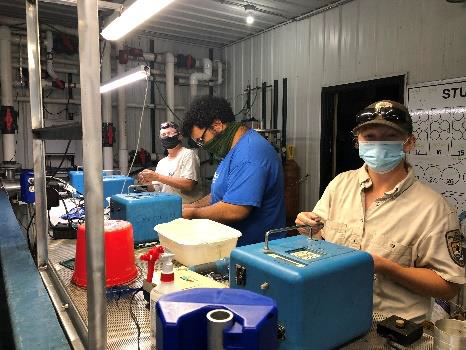
Volunteers tagging Brook Trout and Lake Sturgeon. Photo: Erica Rasmussen/USFWS.
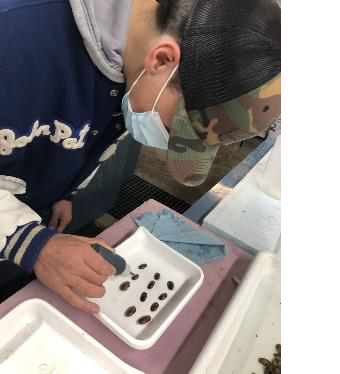
Volunteer tagging Fatmucket mussel. Photo: Erica Rasmussen/USFWS.
2021 was an average year for Mississippi River flows, but after the past few years of high-water flows seemed low. This was especially true in the slough at Blackhawk Park where our Mobile Aquatic Rearing System trailer spends its summer. There were several periods where flows were so low that there wasn’t much, or any, fresh water flowing into the slough from the river and water quality declined several times. As mussels get larger, they’re more resilient to stress because they can stay closed longer, and we saw evidence of this in the Mobile Aquatic Rearing System this year, with greater than 90% survival for our two-year-old and older animals. Survival is always much lower for newly transformed juveniles, and some species had no juveniles survive this summer. Fortunately, we successfully produced many Higgins Eye this year and despite poor survival overall, we collected more than 10,000 juveniles from the trailer in October. These will hopefully continue to grow and survive to be stocked into the Chippewa to continue our reintroduction efforts there.
By: Megan Bradley
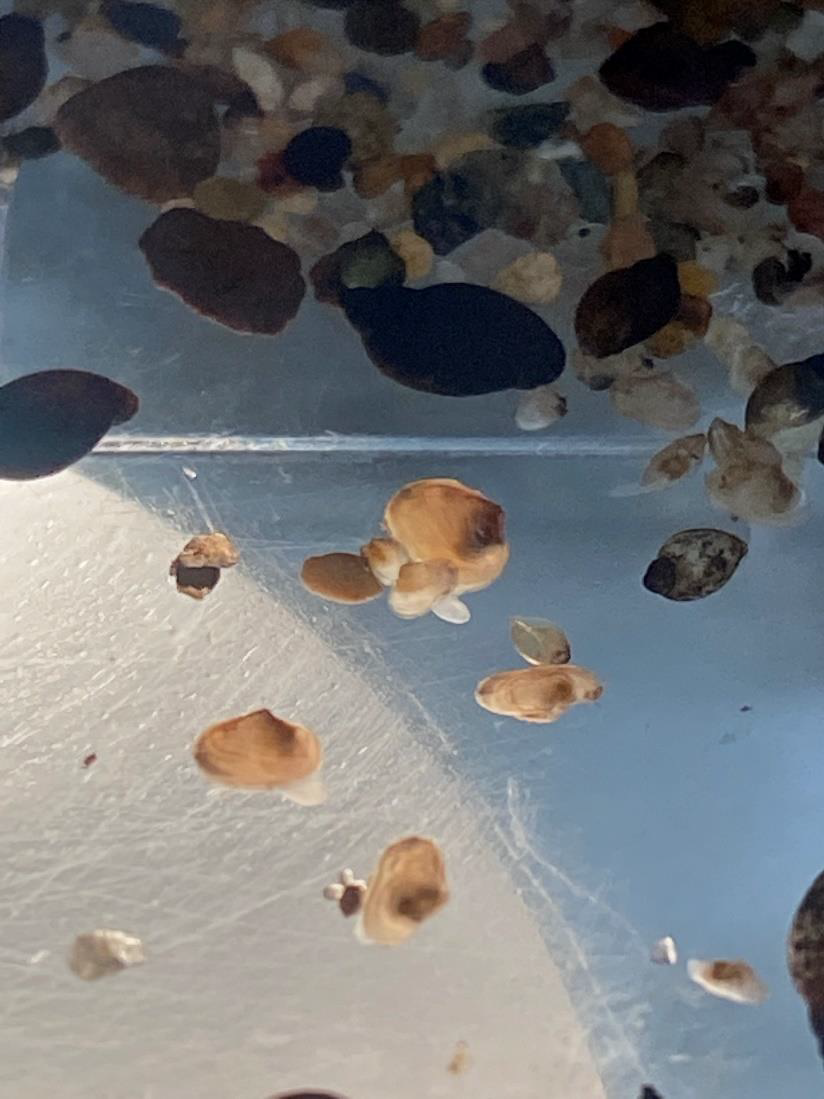
Nine, 2-5 millimeter Higgins Eye mussels crawl around in a petri dish during recovery from the Mobile Aquatic Rearing System (MARS trailer). These animals are still tiny and therefore translucent enough that you can see their dark guts while they crawl around seeking different habitats (flow, food and stable sediment). Photo: Megan Bradley/USFWS.

A hatchery tour can be a great destination to explore and learn new things. This was recently the case for the Schiesher sisters. The four sisters live in different locations throughout the United States and every year they get together to explore a new area. This year they elected to explore the driftless region of Western Wisconsin. One of their stops was at the Genoa National Fish Hatchery. They took a tour of the Great River Road Interpretive Center, stopped at the wonderful gift shop, hiked the nature trail and around the ponds and of course, stopped to feed our brook trout from the floating dock! It is so great to see the excitement on everyone’s faces as the fish jump, scrambled and fought to get some food. They walked away with gifts in hand and knowledge and memories to share with others. They wrote very interesting A++ in the address book. Email or call to set up your tour today! By: Erica Rasmussen
(
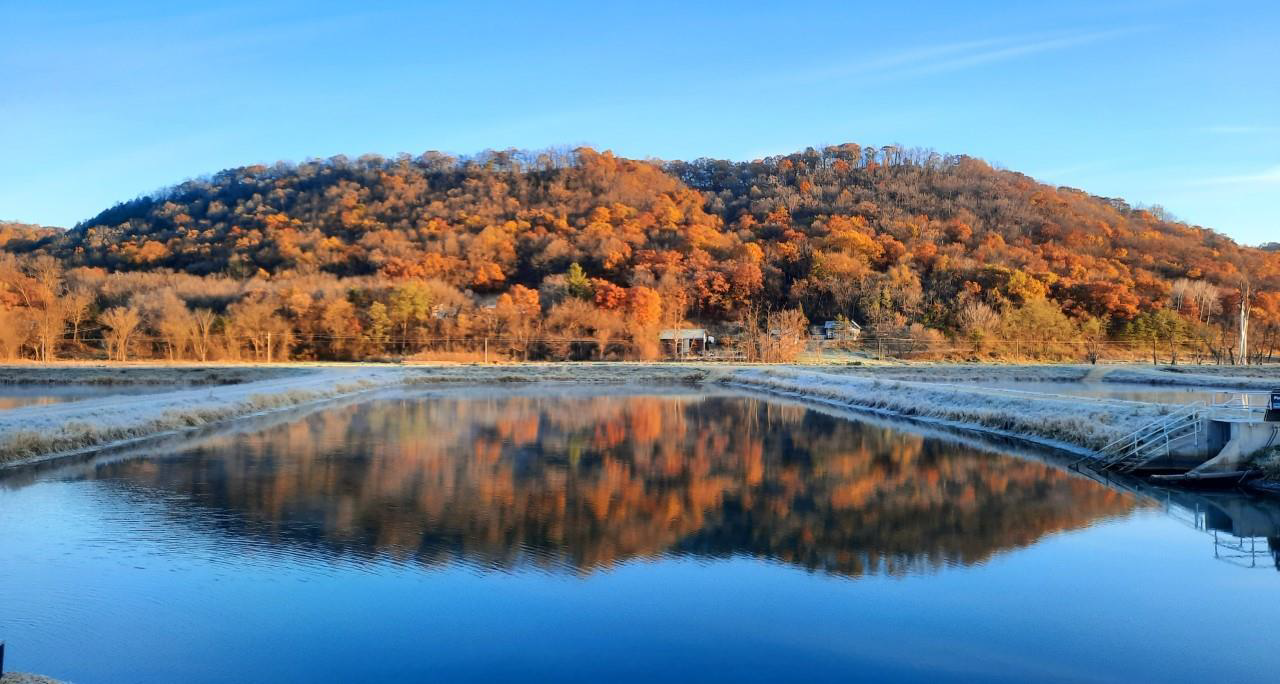
A frosty fall morning. Photo: Beth Glidewell/USFWS.
Fall is by far my favorite time of year. The bluffs begin to turn to their gorgeous red and orange colors,
cuing in harvest season. Farmers are busy bringing in their crops, squirrels are busy storing away a
winter supply, and hunters are out looking to fill the freezer. It’s also harvest time for us at the
hatchery, where we get to see the fruits of our summer labor. We had 16 ponds to pull in with
Largemouth Bass, Smallmouth Bass, Walleye, Black Crappie, Bluegill, Golden Shiner, Fathead
Minnow, and Rainbow Trout included. Some of these fish were settled into their new winter digs at
the hatchery, where we will have five overwinter ponds with mussel host fish, broodstock, Rainbow
Trout for production, and of course our ice fishing pond full of lunker Rainbow Trout! Others were
stocked out to lakes and rivers stretching from Southern Illinois to Northern Wisconsin. It’s always a
welcome sight to see the last ponds come in during the fall and usher us into another beautiful
season, the Wisconsin winter! By: Nick Bloomfield
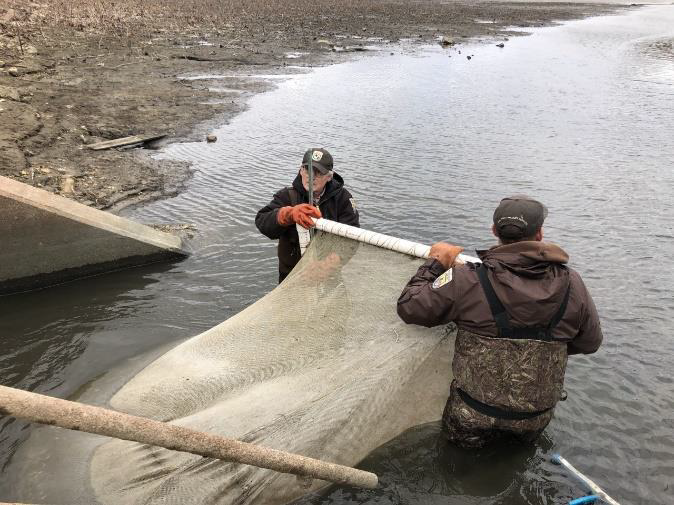
USFWS staff seining for Fathead minnows
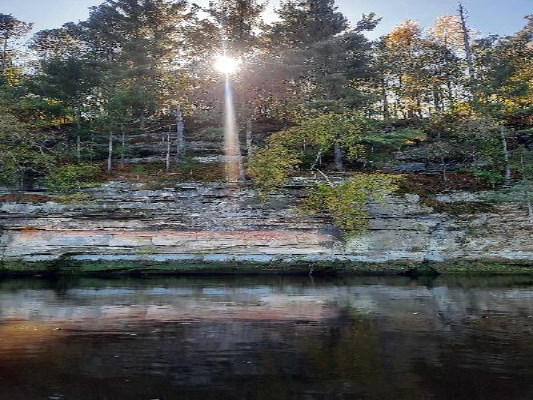
Beautiful views along the Wisconsin River. Photo: Beth Glidewell/USFWS.
In October, Genoa NFH mussel biologists joined colleagues from the Wisconsin DNR in a search for Salamander Mussel broodstock on the Wisconsin River. We were very lucky to have mild weather this far into the fall, leading to a day of spectacular scenery on the river and several gravid female mussels collected. These females will be kept over the winter at the hatchery- the cold water temperatures signaling the females to keep their larvae safe in their marsupial gills- a portion of the gills that are structured to incubate eggs as they develop into mature larvae. In the spring, we’ll remove the larvae from the female’s gills, allow them to attach to gills of Common Mudpuppy, and hopefully produce juvenile Salamander Mussels.
The use of the Common Mudpuppy- the only non-fish host used by North American freshwater mussels- makes this species unique. The Mudpuppy’s large filamentous gills and strictly aquatic nature makes them a very similar functioning host to fish species. They also move between local microhabitats, taking mussel larvae with them, just like a fish host. Both Salamander Mussel and Common Mudpuppy utilize similar habitats- protected spaces under large rocks in swift but stable areas of large rivers. These habitats have always been somewhat rare, but have been severely impacted by human activities leaving both of these species increasingly imperiled and in need of conservation focus. WI DNR biologists will be back in the river at this site and others in the spring looking for additional gravid females next spring propagation efforts- stay tuned for updates from this project!
By: Beth Glidewell
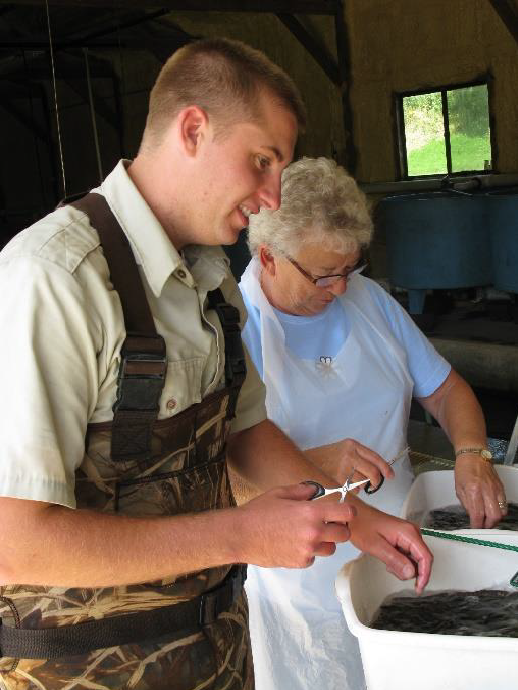
Orey Eckes on the left tagging Coaster Brook Trout with a volunteer on the right. Photo: USFWS.
Meet the new boss….same as the old boss. These song lyrics were written by the Who in one of their most popular songs in the 70’s, and were never more accurate when describing the new assistant manager at the Genoa (WI) National Fish Hatchery. Orey Eckes was selected to replace Angela Baran Dagendesh, former Assistant Manager of the Genoa hatchery.
Angela has moved onward and upward after her decade at the hatchery by accepting a position in the Washington Office’s Division of Refuges. Orey started at the Genoa station in 2011 as a Pathways student and worked his way up through the ranks after earning his Master’s Degree. His thesis focused on an important lake sturgeon life history research question, and in 2013 he completed his thesis on Lake Sturgeon egg development and initiation of exogenous feeding as influenced by water temperature. This project answered a research question that benefited many lake sturgeon restoration programs and their managers including many states, tribes and across a few international boundaries. Recently he served as the station’s primary fish biologist, whose duties included direct day to day supervision of the station’s lake sturgeon production building. We welcome Orey into his new role and are anxious to help him transition into his new role at the hatchery, both serving the staff and the aquatic resources that we have all committed to conserve. By: Doug Aloisi
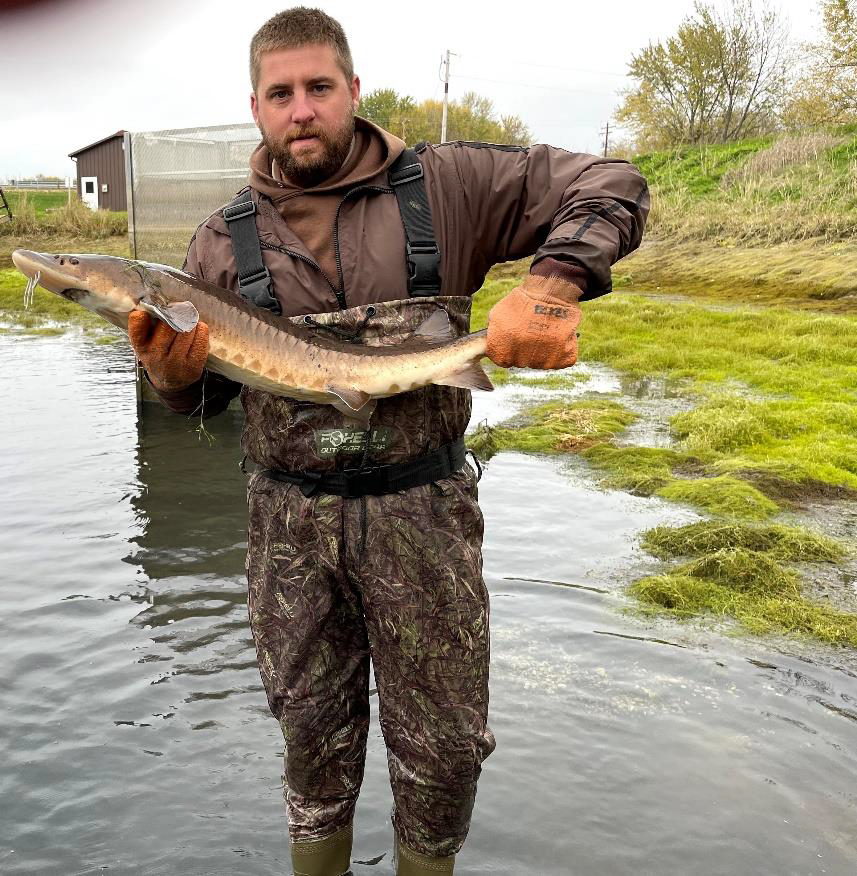
Orey Eckes holding a Lake Sturgeon from the Genoa NFH. Photo: USFWS
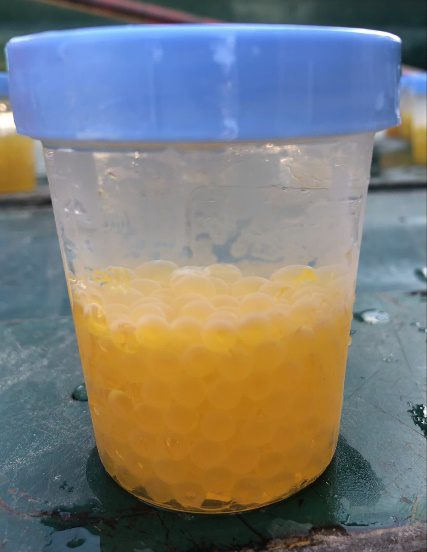
Fertilized Lake Trout eggs
As lake sturgeon culture and pond harvest wrap up for the fall, Genoa National Fish Hatchery staff members begin to focus their attention on hatching cold water fish during the winter months. Genoa staff member (Jeff Lockington) collected wild lake trout eggs from Cayuga Lake, New York. Genoa collects gametes from approximately 125 pairs of lake trout to maximize genetic contribution for future brood lines. Eggs collected from Cayuga Lake are shipped back to the hatchery for incubation in the current regional isolation facility at GNFH. Upon receiving eyed eggs, they were disinfected with iodine and incubated in heath trays at water temperatures between 7-8 °C in an insulated recirculating system. As the eggs begin to hatch, an equal representative sample of fry will be transferred to culture tanks for grow out. These lake trout will remain on station for a year and a half until they clear three fish health inspections by the La Crosse Fish Health Center (La Crosse, WI). Once all testing comes back clear, the fish will be transferred to their forever home at one of our broodstock facilities (Iron River National Fish Hatchery, WI). These fish will serve as future broodstock in the national fish hatchery system. By: Orey Eckes
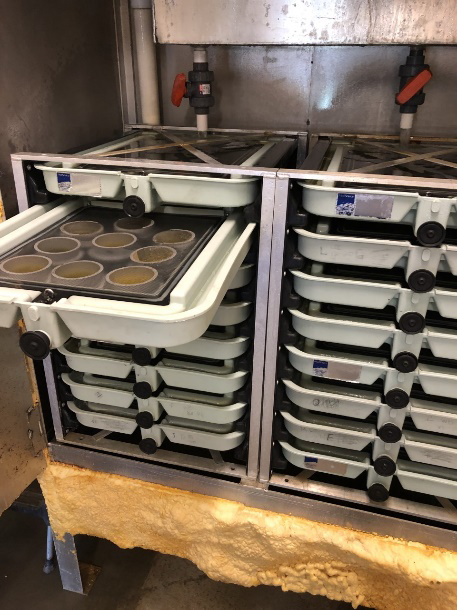
Eggs going into the chiller.
The end of the summer growing season is a busy time for the mussel program. As water temperatures begin to drop, propagated juvenile mussels that have spent the summer in various outdoor culture locations are collected and brought back to the mussel building to over-winter. Culture locations have been selected to provide the juvenile mussels a diverse, natural food base (river water) in a secure location (Dubuque’s Ice Harbor, in partnership with the National Mississippi River Museum and Aquarium, and Blackhawk Park, in partnership with the Corps of Engineers). After a summer of growth, mussels are collected, counted, cleaned, and measured. Individuals that have added sufficient growth over the summer are tagged and released at the end of the fall, others over-winter in rearing pans in the mussel building. This summer, juvenile mussels were placed supsys (Suspended Upwelling SYStems) and newly transformed juveniles dropped off fish in cages in the Ice Harbor. Cages were pulled out of the water, cleaned and sorted by a wonderful group of volunteers, River Museum staff, Iowa DNR staff, and USFWS colleagues. Just over 2000 juvenile Higgins Eye mussels were recovered from the sandy substrate in the cages. Pictures of this event were featured on the River Museum’s social media pages, and on Genoa’s Facebook page. Supsys have been maintained all season by River Museum staff and student volunteers and will be end-of-season processed and returned to GNFH in October.
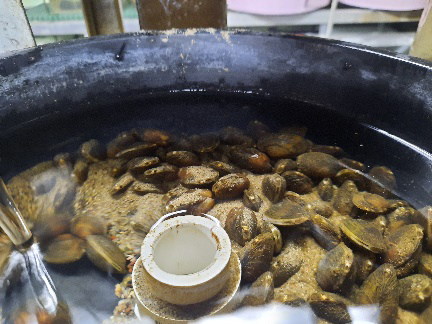
Juvenile Higgins Eye that spent the summer in the MARS trailer are now settled into their winter housing in the mussel building. Photo: Beth Glidewell/USFWS.
Many thousands of newly transformed juvenile mussels and older juveniles of 9 species spent the summer in the MARS (Mobile Aquatic Rearing System) trailer at Blackhawk Park. These juveniles are being counted, measured, and returned to the mussel building throughout the fall. A couple of very dedicated volunteers joined GNFH and other USFWS staff in the processing and counting of cages placed in Pond 14 at the hatchery. This was the 3rd year of an experiment evaluating polyculture methods and pond management. This year’s experiment did not yield any newly transformed juvenile mussels, though about 1000 older Fatmucket juveniles survived and grew to sufficient size in the pond that they can be tagged and released this fall. By: Beth Glidewell
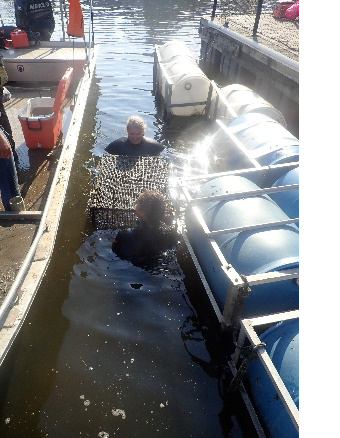
USFWS staff and volunteers recovering mussel cages from Dubuque’s Ice Harbor at the National Mississippi River Museum and Aquarium’s dock. Photo: Erica Rasmussen/USFWS.
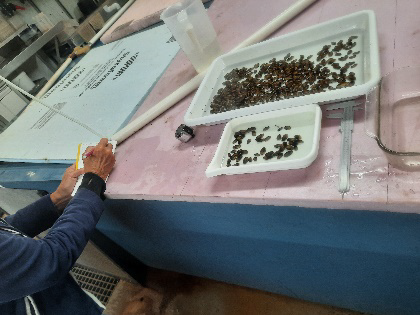
Volunteers helped count, sort, and record length measurements of the juvenile Fatmucket recovered from cages placed in Pond 14. Photo: Beth Glidewell/USFWS.
